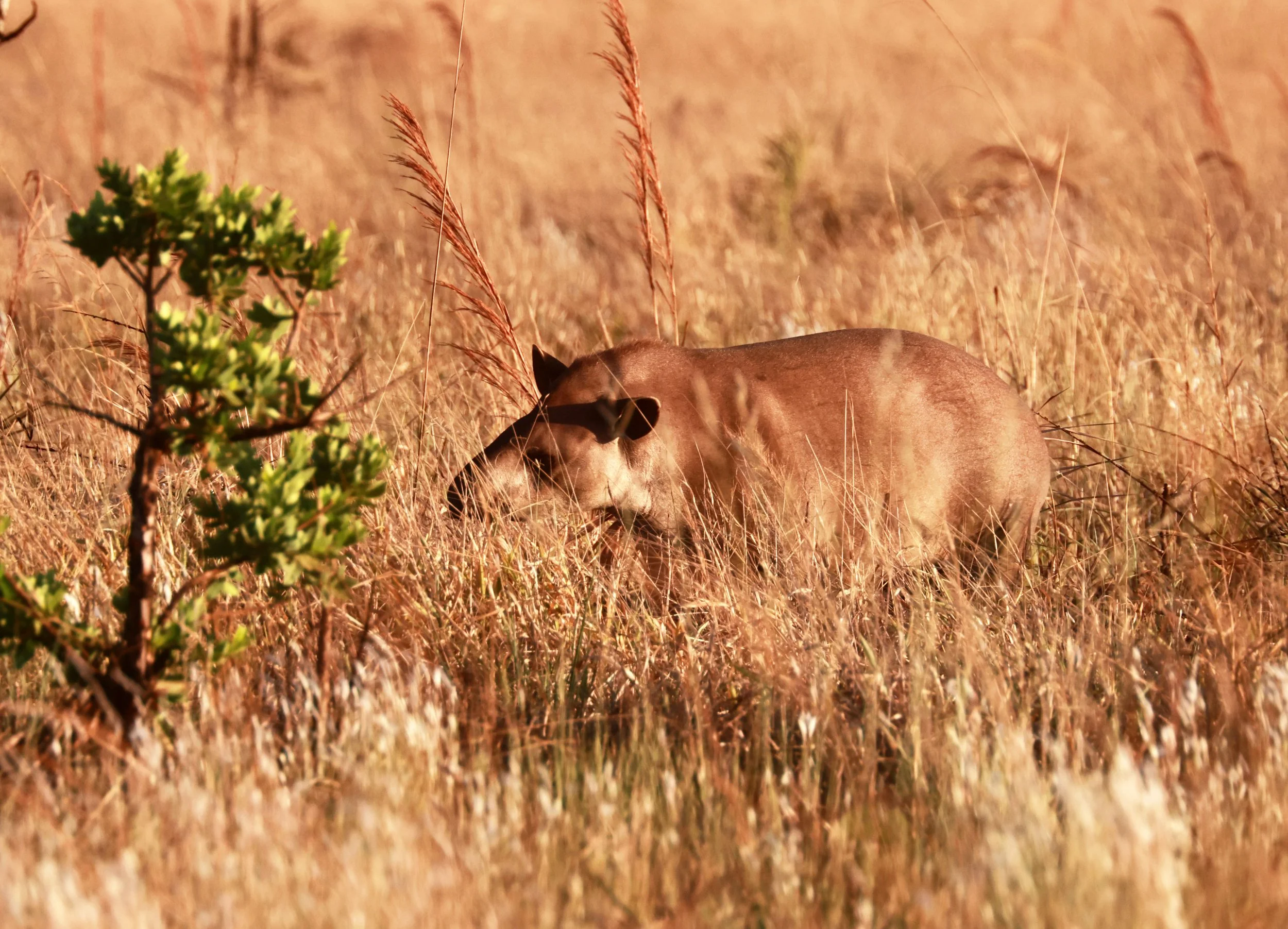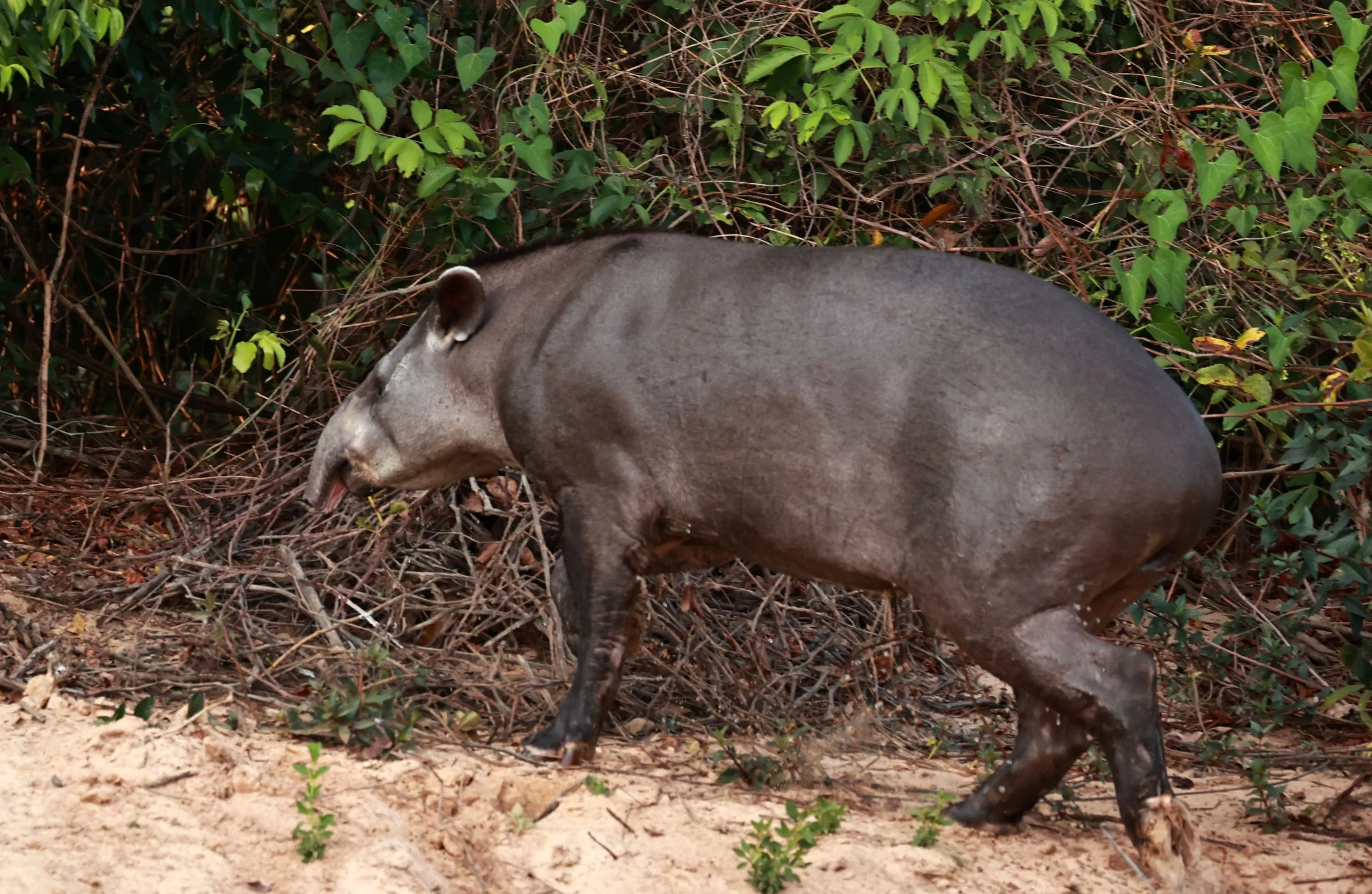
South American Tapir (Tapirus terrestris)
The South American Tapir (Tapirus terrestris), also commonly called the Brazilian tapir (from the Tupi tapi'ira), the Amazonian tapir, the maned tapir, the lowland tapir, the anta (Portuguese), and la sachavaca (literally "bushcow", in mixed Quechua and Spanish), is one of the four recognized species in the tapir family (of the order Perissodactyla, with the mountain tapir, the Malayan tapir, and the Baird's tapir). It is the largest surviving native terrestrial mammal in the Amazon.
Most classification taxons also include Tapirus kabomani (also known as the little black tapir or kabomani tapir) as also belonging to the species Tapirus terrestris (Brazilian tapir), despite its questionable existence and the overall lack of information on its habits and distribution. The specific epithet derives from arabo kabomani, the word for tapir in the local Paumarí language. The formal description of this tapir did not suggest a common name for the species. The Karitiana people call it the little black tapir. It is, purportedly, the smallest tapir species, even smaller than the mountain tapir (T. pinchaque), which had been considered the smallest. T. kabomani is allegedly also found in the Amazon rainforest, where it appears to be sympatric with the well-known South American tapir (T. terrestris). When it was described in December of 2013, T. kabomani was the first odd-toed ungulate discovered in over 100 years. However, T. kabomani has not been officially recognized by the Tapir Specialist Group as a distinct species; recent genetic evidence further suggests it is likely a subspecies of T. terrestris.
The South American tapir can be found near water in the Amazon Rainforest and River Basin in South America, east of the Andes. Its geographic range stretches from Venezuela, Colombia, and the Guianas in the north to Brazil, Argentina, and Paraguay in the south, to Bolivia, Peru, and Ecuador in the west. On rare occasions, waifs have crossed the narrow sea channel from Venezuela to the southern coast of the island of Trinidad (but no breeding population exists there).
Tapirus kabomani is restricted to South America. It is found in habitats consisting of a mosaic of forest and savannah. It has been collected in southern Amazonas (the type locality), Rondônia, and Mato Grosso states in Brazil. The species is also believed to be present in Amazonas department in Colombia, and it may be present in Amapá, Brazil, in north Bolivia and in southern French Guiana.
Brazilian Tapir grazing in Rio Doce State Park, Atlantic Rainforest
T. terrestris is an excellent swimmer and diver, but also moves quickly on land, even over rugged, mountainous terrain. It has a life span of approximately 25 to 30 years. In the wild, its main predators are crocodilians (only the black caiman and Orinoco crocodile, the latter of which is critically endangered, are large enough to take these tapirs, as the American crocodile only exists in the northern part of South America) and large cats, such as the jaguar and cougar, which often attack tapirs at night when tapirs leave the water and sleep on the riverbank. The South American tapir is also attacked by the green anaconda (Eunectes murinus). T. terrestris is known to run to water when scared to take cover.
The South American tapir is an herbivore. Using its mobile nose, it feeds on leaves, buds, shoots, and small branches it tears from trees, fruit, grasses, and aquatic plants. They also feed on the vast majority of seeds found in the rainforest. This is known because the diet is studied through observation of browsing, analysis of feces, and studying stomach contents.
Road kill Tapir in Goias State near Emas National Park. On our five our drive from Campo to Emas, we counted at least SIX dead Tapirs. Road hill is a huge threat to these animals.
Although it has been determined via fecal samples that T. kabomani feeds on palm tree leaves and seeds from the genera Attalea and Astrocaryum, much about the diet and ecology of T. kabomani is unknown. Previously discovered tapirs are known to be important seed dispersers and to play key roles in the rainforest or mountain ecosystems in which they occur. It is possible that T. kabomani shares this role with the other members of its genus although further research is required.
T. terrestris mates in April, May, or June, reaching sexual maturity in the third year of life. Females go through a gestation period of 13 months (390–395 days) and will typically have one offspring every two years. A newborn South American tapir weighs about 15 pounds (6.8 kilos) and will be weaned in about six months.
The dwindling numbers of the South American tapir are due to poaching for meat and hide, as well as habitat destruction. T. terrestris is generally recognized as an endangered animal species, with the species being designated as endangered by the United States Fish and Wildlife Service on June 2, 1970.[20] It has a significantly lower risk of extinction, though, than the other four tapir species.
The individuals in the below gallery were photographed in Emas National Park, Goias, Brazil

Individuals in this gallery are from Emas National Park, Goias, Brazil





















































































































































































































The individuals in the below gallery were photographed in Rio Doce State Park, Minas Gerais Brazil
























































































The individuals in the below gallery were photographed in Encontro das Águas State Park, Porto Jofre and Porto Alegre Lodge, Northern Pantanal:































































































